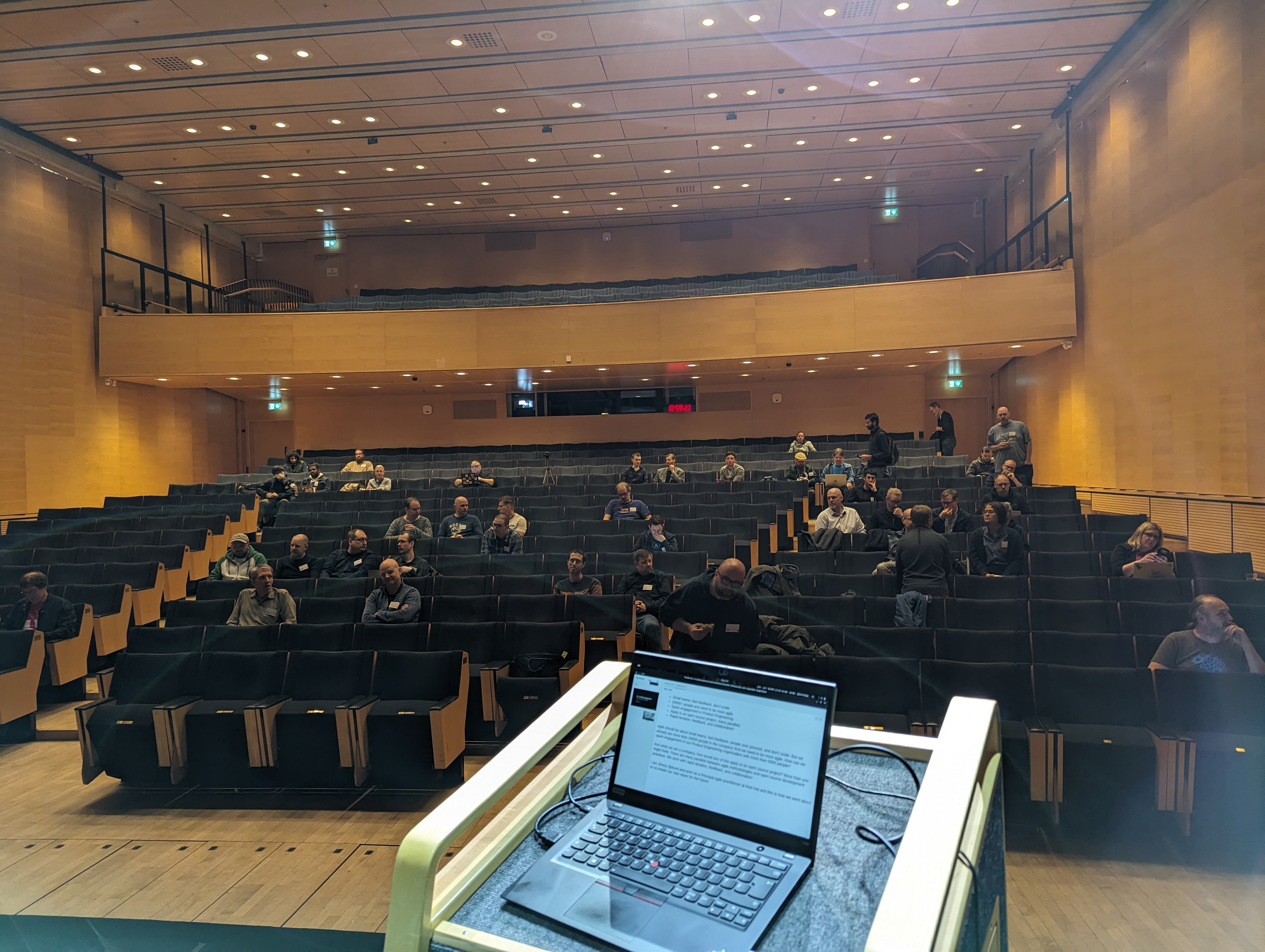foss-north 2024
Foss-north is a small conference hosted in Gothenburg on the west coast of Sweden. I have wanted to go for years and even though I now live quite close it just haven’t added up the dates. Until now!
I pitched a variant of my previous talk on “Co-creating a vision in the open with 5000+ people” to a more community perspective. My thinking being that it’s a an open source framework and would be a great fit for smaller and larger open source communities as well as companies. My talk Co-creating engagement with the Open Decision Framework was accepted and I was looking forward to visit the conference as well as pulling the open source community parts into my talk.
Due to family logistics I could not participate on all sessions but I did manage to see some of them. The conference is usually very technical and I believe this year was no different. Sometimes I was lost after the first initial slides but overall it was two interesting days.
foss-north is a free / open source conference covering both software and hardware from the technical perspective. We provide a meeting place for the Nordic foss communities and will bring together great speakers with great audiences.

The conference spans two days and in Chalmers University of Technology in Gothenburg. The venue was good, but this year less participants than I had expected. As I have not been to any of the previous events I based my assumption on the visible audience in the YouTube videos.
Here is a selection of the talks I attended.

Magnus Feuer had prepared a one hour talk, but changing employer just two weeks before his talk he did not get approval to talk about everything in it! Surprise surprise. He did what he could with the approved, generic parts but the talk was very short. It seemed to have been a great talk and I wished we could have gotten it in full. The content was on how to get vehicle companies contributing back to all the open source software they make use of. Hint: They don’t. But also interesting and funny to hear about his experience in trying to get something in upstream, while holding up the delivery of potential hundred of thousands of cars. “It would be better for our maintenance if this was included upstream” didn’t seem to catch much pity in the factory.

I was up next after Magnus and since the break in between was much longer than expected, it took a while for everyone to get back. I estimated about 40-50 people in the room once I started.

The presentation went fine. I was worried I wouldn’t fill the time and tried to talk slower but half way in I got the “10 min left” sign and had to speed up a lot for the second part.
I didn’t get any questions in the QnA section but there was several people coming up to me during the following breaks through the two days, to ask questions and express their gratitude for talk.
My main takeaway and boost was when an attendee from a major organisation came up to me to discuss a bit more. He shared that my talk was one of the two reasons he attended the conference at all! That makes me sleep well at night. If I manage to reach only one person, it was all worthwhile.

Following my talk was Ramarro Marrone on Dwindling software freedom in the R ecosystem which was another fun talk! He was very freedom focused and sharp about propriety software, but in a fun way. I really enjoyed his talk and as I have had on my ToDo list for some time now to learn more about R and RStudio I got some valuable tips in his talk.
Apparently I was so intrigued by Agustin Benito Bethencourt’s talk Introduction to Software Heritage, the Alexandria library for code that I forgot to take any picture. Probably a good sign. It was a fun and engaging topic to conserv all the code written, but I couldn’t help getting back to question “Why?” Do we really need all code written in the past? Some are interesting, fun, educational, but there’s a lot of code that should just be forgotten and why would it take up space and effort somewhere? A person in the audience also asked a similar question when he discovered that a piece of code he wrote “while a bit drunk on a weekend evening” was in the library and how could he make it go away? Which, of course, they have a process for.
While some talks were very technical there was another spread on the design of speaker’s slides. Everything from our Red Hat templates, with smooth and pretty look’n’feel to the ones that was probably made in emacs (And I love emacs, I wrote this blog post in emacs). Which is something I appreciate with these conferences! The variaty of speakers that seem so confident and could talk without slides to the one that actually read everything from the mobile phone on stage.

And the winner of “smallest font used in a presentation” went to RISE and their Software Reuse through Open Source Software in the Public Sector - A birds-eye view on Policy and Practice:


Coming in second in the “prettiest slides” category was fellow Red Hatter Fabio Alessandro Locati talking about Ansible. His talk was probably more in line with the expectations of the audience than mine, and he got good engagement with people throughout the conference. And it was great to him in person. We also met another Redhatter based in the Gothenburg co-office.

One of the best takeaways for me was from Tryggve Mathiesen’s talk on Pervasive and Sustainable AI with Adaptive Computing. I only understood a couple of slides and totally zoned out when he went into details on hardware and chip design.


